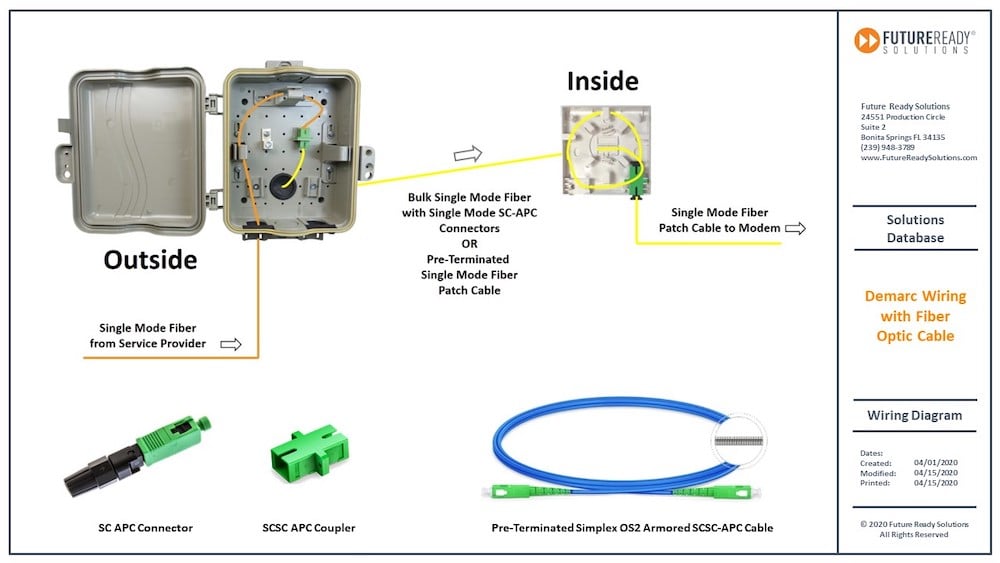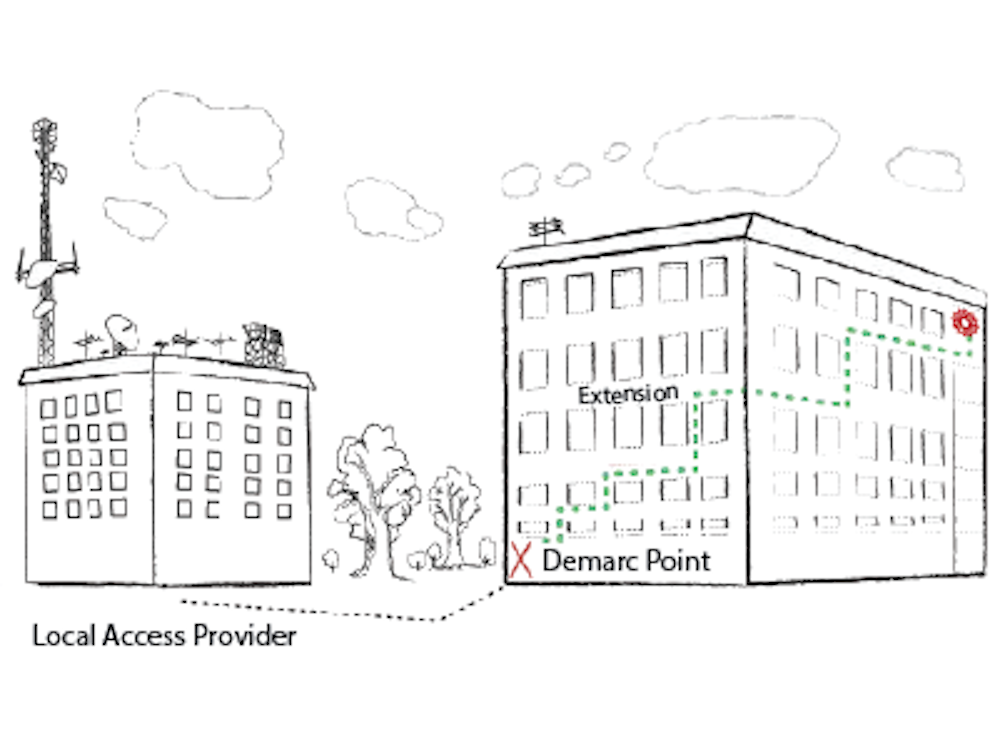If you’re looking to upgrade your current business communications strategy, make sure you know the basic terminology before you dive in.
Demarcation points help customers to determine where their private phone network begins and where the public switched network ends and allows you to have much greater flexibility when it comes to choosing your phone provider.
Read on to learn the definition of demarc, what it’s used for, the different types of points, and more.
Table of Contents:
- What is a Demarcation Point or Demarc?
- A Brief History of the Demarcation Point
- Uses of a Demarcation Point
- Different Types of Demarcs
- Global Demarcation
- Demarc FAQs
- Looking for the Right Business Phone System?
What is a Demarcation Point or Demarc?
A demarcation point (sometimes referred to as demarc, dmarc, point of demarcation, or network boundary point) is the physical point where the public switched telephone network ends and a customer’s personal network or the private network of an organization or business begins.
Essentially, this point of entry is where a phone company’s wiring meets a subscriber's wiring, and serves as a physical representation of which part of the network is public and which part is private.
It is also referred to as a meeting point for phone equipment from a network service provider and telephone customer-premises equipment. Note that all dmarc points have R-11 jacks that connect to the phone network, as well as smaller phone cord loops that use modular connectors to connect to phone jacks.
In homes, the dmarc is the network interface device (NID for short.) Though NIDs are also used in corporate points of demarcation, the situation is slightly more complex. This is usually because there can be a larger physical distance between the service provider network and the private customer-owned network.
For example, if the point of demarcation is located on the ground floor of an office building, corporations with offices on the 9th or 10th floors will need to connect their private network to that point of demarcation several floors below.
In these cases, cabling is installed to extend the point to meet with a customer’s private network so that it is within the customer premises. This process is known as a demarc extension.
In private residences, the dmarc is often located at the first socket or a small junction box on the home’s exterior. For companies, a bigger box containing the point of demarcation is located somewhere within the building’s perimeter at the main distribution frame (MDF.)
Either way, it will be fairly easy to find, as the goal is for it to be accessible to a technician as quickly as possible in the event of an issue.
You may also hear about a term called the Minimum Point of Entry (MPOE.) This is where the provider's wiring crosses into the private building.
Note that choosing Internet service from a local cable or telecommunications company also results in the installation of a dividing line point of demarcation.
A Brief History of the Demarcation Point
The point of demarcation wasn’t always as simple as it is today.
It’s history dates all the way back to 1886, the year that AT&T was founded. Given that it was really the only game in town at the time, the company quickly dominated the telephone market within the United States. Because it was growing at such an exponential rate, the company was at one point the owner of the local loop -- both the customer’s wiring and phone equipment.
This lasted up until 1956, when lawsuits against AT&T erupted, demanding that it no longer deserved a natural monopoly over the local loop. It took until 1974 for the DOJ to file an antitrust suit against AT&T that ended in a settlement in January of 1982.
The settlement was called the Modified Final Judgement (MFJ) and stated that as of January 1, 1984, AT&T was required to divest from local exchange service companies. Instead, these companies were divided up among 7 Regional Bell Operating Companies (RBOC) that were legally required to give competitors equal opportunity. Additionally, phone companies could now sell third-party telephone equipment -- meaning that Americans could finally have phone service from someone other than AT&T.
This is how the need for a demarcation point was born.
Since customers didn’t have to get their phone systems from AT&T exclusively, the point of demarcation made it clear which portion of the network was owned by a consumer, and which part was the property of the phone company.
Uses of a Demarcation Point
Primarily, a demarcation point makes it clear who is responsible for wiring, telephone cords, and equipment management, installation, and maintenance.
If the wiring is past the point on the customer’s side, then they’ll need to pay for any repairs. But if there is a wiring issue on the POTS network side? Then the telephone company is required to fix the issue.
Note that in certain services, like an Integrated Services Digital Network (ISDN) there is both an NID and network termination unit (NTU.) In this case, the business phone service provider’s responsibility would include both everything up to the point and the NTU.
A point of demarcation also exists to protect wiring and equipment from damage caused by electrical surges thanks to its surge suppressor devices. It makes it much easier to troubleshoot network problems, as customers can easily disconnect from a telephone company's wiring if needed.
It is what makes it possible to connect a customer’s third-party equipment and wires to the public network. Without a demarcation point, customers would not have the level of flexibility and number of options when it comes to service providers.
Depending on the needs of the customer, specialist equipment is also available.
For example, it’s possible to add extra layers of network protection for a higher overall level of security. Uses can also add fault propagation features, which automatically reroute traffic that runs into link failures and sends out customers and access providers failure messages.
Different Types of Demarcs
There are three main types of demarcation points for business phones: Network Interface Devices, Smartjacks/Intelligent Network Interface Devices, and Optical Network Terminals.
NIDs are the most basic, and therefore the most common type.
They are small, weatherproof boxes with ratings that are regulated by the FCC, and they don’t have any digital functionality. The boxes themselves are the surge protectors and contain a test jack, circuit protection, and wiring termination.
Smartjacks or INIDs are like an upgraded version of NIDs.
They’re usually used for T1 lines, triple-play providers, and other, more complicated, services. They use circuit boards as opposed to the more basic wiring of the NIDs, and can help strengthen your signal. Best of all, they don’t require customers to run a DSL through their buildings. They also usually have an alarm system that lets customers and providers know if there is an issue.
Optical Network Terminals (ONTs) runs via fiber optic cables that help to provide a much faster, stronger signal.
However, since they are not capable of providing their own power, they must use power provided by an external source. The good news is that most come with backup batteries in the event of a power failure.
They are an excellent alternative to standard copper wiring.
Global Demarcation
In the United States, the Federal Communications Commission (FCC) states that the point of demarcation has to safely connect public switched telephone networks (PSTN) and on-premise customer VoIP and landline and Internet access equipment.
However, it’s not the same worldwide.
In the United Kingdom, for example, the demarcation point is within a phone jack (the LJU master socket, to be exact) with wiring that is owned by both phone companies and private consumers. This means that any new hacks are the property of the private customer, and new NTE5 jacks offer removable panels containing customer wiring.
In Canada, the point of demarcation is usually a junction block that connects phone extensions together to join a network. These junction blocks also have a lightning arrester, which means they must be wired to the ground.
Demarc FAQs
Q: How much does a demarcation point extension cost?
A: Though the cost will vary depending on the location of your business in relation to the original point, extension costs usually begin at $300 for a small business. In many cases, the extension can be finished in just one day.
Q: Can I perform basic maintenance myself?
A: You can attempt to perform basic maintenance on your side of the wiring. Note that the provider's side of the box is usually blocked off with a special screw that only the telecom company can remove.
This quick demarc maintenance guide provides you with some easy troubleshooting tips.
Q: Who can I contact to repair wiring issues on my side of the point?
A: You are usually not required to have the phone company providing you with services also repair the wiring you're responsible for fixing. However, most providers will offer a protection plan for your side of the wiring to make maintenance easier.
Looking for the Right Business Phone System?
Now that you know more about the definition of a demarcation point, you may want to reconsider your current phone system.
Want to learn more about the differences between Voice Over Internet Protocol (VoIP) business telephones and Plain Old Telephone Service? Curious about what to look for in a VoIP provider?
Our interactive table on the top business VoIP providers in 2021 and beyond is a great place to start.






